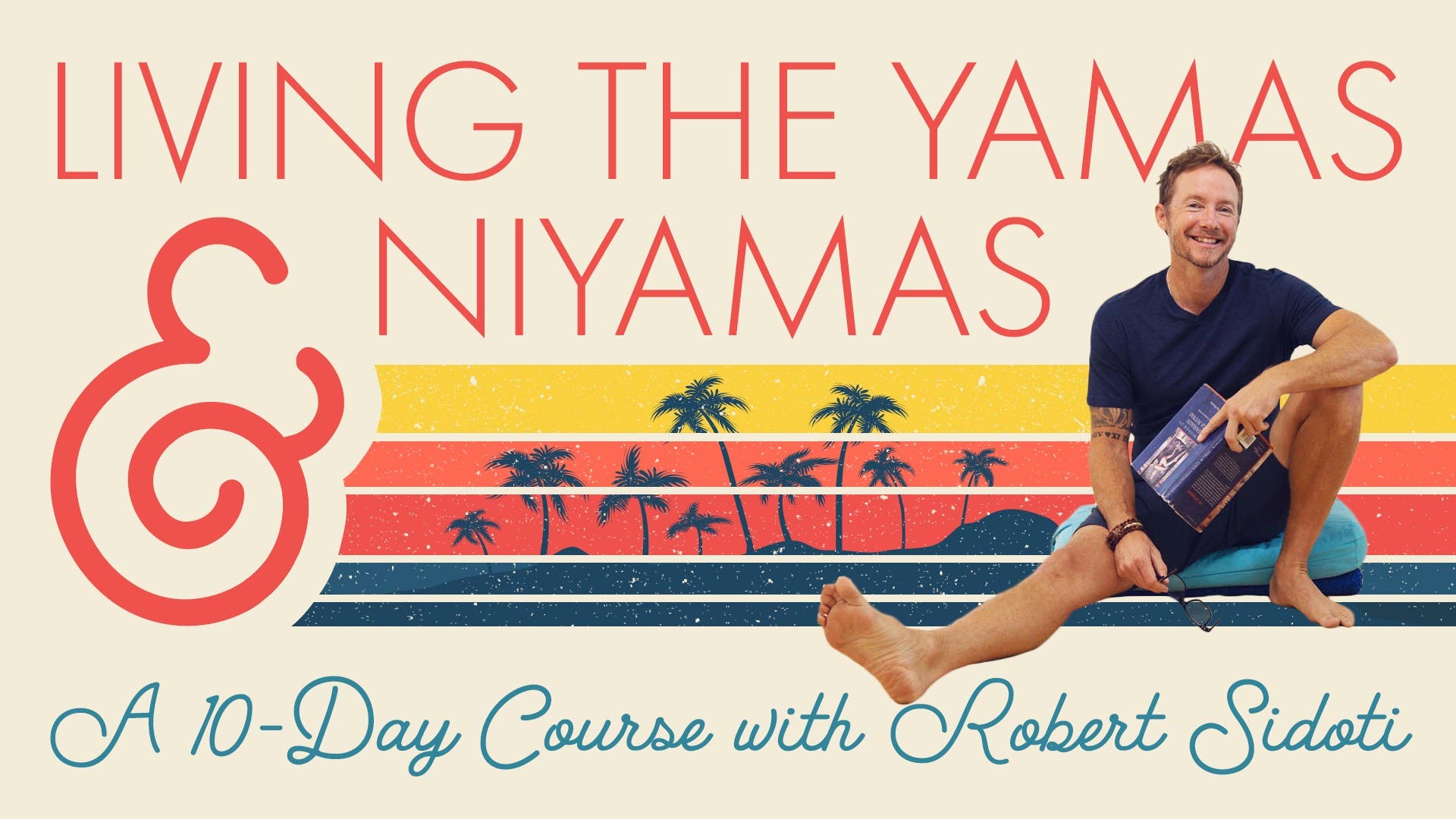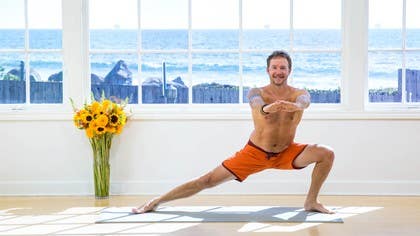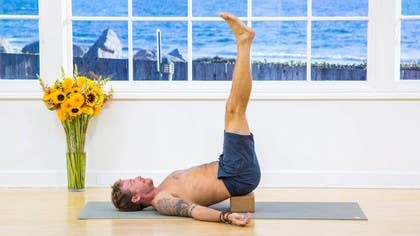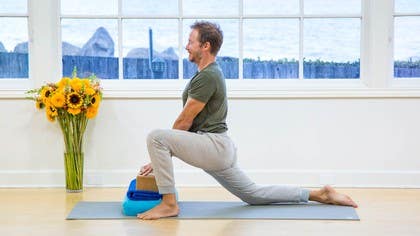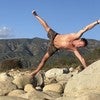Description
About This Video
Transcript
Read Full Transcript
Hey there, welcome back. Number 10, this is our 10th session together, if you've been with me the whole way through. This is Ishvara Pranidhana. This is the fifth niyama and the 10th practice in this series. So I got my cozy sweatpants on, cozy shirt, we have a bolster, a blanket, some blocks.
We're going to have a supported practice today. This is going to be like we're going to do everything we can to give full permission to feel supported. So in this practice of Ishvara Pranidhana, right, the text says it's a surrender to a higher God, to a source, to the universe. So that's a tricky one, you know, it's a tricky one because we all have our own specific beliefs and non-beliefs. So this one, as you're sitting there with me now, who is that for you?
What is that for you? And can you or do you already have this sense of, I don't do this all on my own. This is not all me, right? That'd be a little maybe inflated ego even. I've got help.
I have support from the universe, right? From God, there's a plan. And man, like if we can drop into that from time to time, what a relief, what a relief to not feel the pressure of I've got to go at this all on my own all the time. Now with that said, my own personal experience with that is that, you know, throughout my life by choice and design, I've always been fine. Like I've kind of gone it alone on my own.
I mean, I've had help within relationships and all that, but like my family and friends because I don't allow them to, they assume that I'm always good, right? This may resonate with you in some way. So I'm learning over the years how to be more vulnerable, right? And share my insecurities or my shortcomings or my failures or where I'm feeling sad or, you know, whatever it might be, but to actually give the universe, give family, give friends the opportunity to be there for me, right? It's, you know, it actually conjures up some emotion in me because I need to do it.
I need to do it. It's nice to have that help, okay? So whew. But it's really good. I've had small moments of it and with it and I want more of it.
So with that said, this practice is important for me. I hope that it can be important for you in some way. Like I said before, this is supportive, right? So full permission to be held by the ground, by the mat, by the bolster, the blanket and we'll go through several shapes and we'll hold for a few minutes in each shape, okay? So just kind of give yourself, give yourself to it and feel held and supported, all right?
Good plan. I'm ready. I'm completely ready for this. So let's begin in a child's pose. So this child's pose will look a little something like a basic, your typical child's pose.
And again, don't be afraid to like bring this ground way up. Like you can, child's pose can be right here, right? So find it, make it the most comfortable and like, and lean into it. Like you're about to kind of give yourself up and be vulnerable in a conversation with a friend, with a God, whatever, and just kind of let go into it. It's not easy.
It's probably one of the more difficult practices we've been working on together. So child's pose. You can cozy that bolster way up into the inner thighs. You can wrap your arms around the outer edges and the forehead can go straight down or the right side or left side of your face. Let's take a full breath in together.
You and I inhale and exhale, try to relax your shoulders. So there's this like, like a final relaxation quality. You let your body completely relax. There's a mantra and a saying that I will typically find myself saying to myself in different moments of my life, everything's going to be okay. Even when it isn't, there's this trust that everything has a plan.
Everything's going to be okay. And that supports me. That makes me feel held in a way. This isn't a practice about, you know, being weak. If anything, I think it conjures up and cultivates more strength.
Your breath is there to support you. You have a whole support system. Your internal organs, your nervous system, loosen the jaw. Take deep breaths when you feel like taking a deep breath. Good, you can move the blood come up out of this.
So there'll always be these little moments where we transition in this transition. I'm actually going to put a block in the middle of this set up here. And we're going to spend a little bit of time in downward dog. Not as long as where we just were, maybe five, seven breaths. Stretch out the backs of the legs and the block is there for my head if I'd like to rest my head in downward dog.
So find your alignment and downward dog. You've got your set up, your support system right there and figure out how you can use that support system to rest the head. Not work so hard here. Just enough to hold the shape. The forehead, the top of the head, whatever feels best.
I have my forehead on the block. Backs of the legs opening up, spine is long and neutral. And bring the knees down. Empty pose so you can simply turn the bolster, your support system, whatever that is. Bring the knees below the hips, elbows or forearms.
I like to put the elbows on the bolster or blanket. Press the palms together. We did this in the fifth Yama together. We had that mellow chilled out practice. Keep the hips up over the knees.
Elbows can go a little bit wider if you feel a little crowded in the shoulders and head. And the forehead rests on the blanket, bolster, pillow, whatever you've got there, block. And right now could be a nice opportunity. It's sort of like giving your heart, like it's a heart opener here, right? Your heart is kind of falling or dropping or leaning toward the floor.
So you let go, you give your heart to that higher source, that God, which is a thought. Try to find the ideal shape, right? We're using this like yin style restorative approach. Where can I be and feel more supported or allow that support? The belief that there is so much more than what I can even see or feel.
But if we tune in through these practices, these teachings, the more we tune in, the more clarification or more moments we might find in the day or week or month, or those signs that, whoa, wow, there is a little bit of a plan, I do have help. And in these shapes, when you feel tension, like let the tension go, the tension leaving is that trust that you have, that the body, the bones, the support system is there to hold you. You don't have to use all your muscular effort. Continuing to tune in intimately with your breathing, adjusting your body from time to time. Okay, start your exit strategy.
There's always this strategy in exiting these poses, you might push back into, ooh, that's a lot of the shoulders. Push back into child's pose for a moment, relax the shoulders, the head, nice. We're going to move into like a loungy lizard pose now. So this position, this setup you've got here, you can bring the blocks over, let's see what that feels like. We'll do this a couple of different ways.
We've got long enough time in the pose to figure out what works best. So the right foot steps up and out wide, and the hands here are propped up on the blocks, as high as you can get it really, so that the arms, see my arms are straight. I'm not really working, I'm trusting in the sort of stacking of my bones of the arms to lean into the lunge, to lift the chest, to relax into the shape. That would be option one. Option two could very well be forearms down onto the blanket or bolster, but if that brings a heightened, overly heightened sense, come back up higher.
Relax the head, the neck, the shoulders. It's hard to relax the shoulders in this shape because you are holding yourself, so do what you can. This type of practice, as well as the Iparigraha practice we did, the fifth yama, are probably some of the more difficult practices for us to do because we kind of feel like what's really happening. There aren't that many results, let's say, besides a deep stretch, but if you can kind of put in your back pocket this feeling of just trust, trust, trust, trust. There's a lot more going on than this lizard pose right now.
Don't be afraid to swerve around, right, lean, left, lean, right, behind the little pockets that are a little more difficult to get to. They take time to get to in the hips, and... Let's switch sides. Take your time coming out of these poses after being there for so long. It deserves a little respectful exit.
You can straighten out the right leg, push the hips back, get that little counter pose. Good. You may be like me, and a lot of other people out there, when you begin these yoga practices, the props, step the left foot up, I'm going to come up high first. The yoga props are crutches, and you start to lean into it, breathe. I didn't look at them as support or ways or means to better alignment, I looked at them as like a weakness, you know, I don't need a block, I'm good.
Meanwhile I dismissed the support and suffer, suffer in the shape, or if I would have just accepted it, learned how to use that support, wouldn't have had to suffer so much, maybe even get injured. So this type of practice I'm getting at is, how can we really like lean into these props, use the props as a support system so that we can be in the shape in the most optimal aligned way, reducing injury and unnecessary stress and tension. I'm choosing to stay up high for this one, if you'd like to come down to your forearms, that's your call. In my mind, this type of practice, you're looking at, you know, 65%, maybe 75%, that threshold of intensity. So, I'm going to come down here, I'm going to come down here, I'm going to come down here, exit strategy once again, push the hips back, straighten out the left leg a little bit, reduce the intensity in that right hip flexor area, lengthen out the hamstring of the left leg, ah, good, alright, you can move the blocks away, I don't think you'll need them, we're going to do the twist now, so come on to your right leg or come on to your seat, kind of like so, we'll take a moment to set it up so we can get into it in the most optimal way, alright, so right leg bent, left leg bent, to your degree doesn't really matter, what we're looking for is some ground here, sit up tall, twist to the right, and now you've got this support system you can completely lean into and onto, continuing to twist and lengthen to deepen, alright, so finding the twist, if you need to bring it up, bring it up higher, higher, higher, and just like we did in child's pose, we find this like, arms wrapped around this support system, embracing it, you know, get the twist of course, right cheek down, or left cheek, or maybe even the forehead as you drop in, this is about two and a half, three minutes or so, find a groove and a rhythm with some flowing breath in and out, and we're looking to cultivate more and more interest of stillness and pausing, the quiet space in your life, one minute, twenty minutes, an hour of every day for contemplation, and checking in with yourself, where am I, what am I doing?
Releasing each and every exhale softly. Let's begin the exit once again, nice. So for the sake of, you can just flip it right on over and take your left hip up to this, I'm going to switch it to the backside so we can see the leg position if that's helpful for you. So the left hip draws up tight to the bolster, legs are bent and whatever comfortable shape works for you, turn your body to the left, as upright, right, as upright, that's spot spiraling kind of effect, hands come down to the mat alongside that bolster, and you know you've got the time so no need to rush into it, take it one breath at a time. And remember it's either your left cheek, right cheek, or forehead, holding on, embracing the support system you've got, leaning into it.
It's a little more difficult to breathe when you're in these deep twists. So that extra effort to fill the belly, fill the back body, the ribs, the chest, and release it. And you notice when you release your body you're able to continue to adjust, you free up space. I know I say it all the time but that exhalation is pretty powerful. Let go.
Whenever there's lengthened periods of time where I might not be cueing, talking, I'm right here, and I'm here for whatever it's worth as support, supporting, holding space for you to let go into. All right, one little step at a time to come out. All right, you can take a little counter twist if you'd like. And we'll set up the next shape. So the next shape is bound angle.
So actually, I think it might be nice if you take, if you have a blanket that was up on top of your bolster, place it under your seat and sit on the edge of that blanket that'll give that adjustment in the pelvis. And then, depending on the depth in which you're able to go, the prop you have, pull the prop up into the body, up on the highest kind of vertical position. And option would be to lose it completely and simply sit upright because that's enough for you, or slowly start to curl into the shape, of course, with breath. Maybe the forehead ends up landing on that bolster, not forcing anything. Before you force anything, get something bigger, something that comes up a little bit higher.
When you land in whatever chosen or whatever place your body allows you to be, let's come back to our breath. The nice gesture with the palms in these postures, palms up, so it's got this receiving quality, receiving the assistance, the support, the help, kind of giving into it. Reminding ourselves that we don't have to try so hard all the time. Relax. Relax.
Relax. Relax. Relax. If you're not already for the remaining time here, tune in very intimately and specifically to your breath. And feel into that as a real genuine support.
Relax. Relax. If you're folded forward, take your time to roll up, almost reluctantly departing the posture. I know I was. You can take your hands back behind you, let the bolster kind of fall over for a moment and press the chest upward, maybe even lift that chin, throat opening, breath in, breath out.
All right. Let's switch gears a little bit now. Give me 30 pushups. That would be a terrible transition. We're going to come on to our back.
So stack up again. You can stack up as high as you'd like. We're going to place our low back on top of this blanket and bolster. So make sure it's comfortable. So it's the low back, even part of your bottom, rear buttocks.
And you can take a few moments, we'll be here for minutes or so, kind of wiggle around and ground and like settle into the support system once again, right? Takes practice. Takes practice trusting, letting go into that space being held. So let's talk options again. So options would be bent legs, feet below the knees, knees drawing toward one another.
That's too much work and it doesn't feel good. You could draw the bottoms of the feet together, draw the knees out. You could keep the knees stacked up right over the feet, more neutral or take the legs stretch them out. That might add some extra flavor through the hip flexors, that waistline, hip flexor area your thighs and your arms, wherever it feels most natural. Right here with you, breathing in and breathing out.
I'm going to make one adjustment with my legs straight and come back and bend them and look to draw the tailbone, almost like I'm tucking the tailbone under a little bit and then send those legs out again. Arms are out wide, possibly palms facing up, feet open out wide so you've completely given in to the shape, to the earth, the ground, the floor, the props and you trust everything's going to be okay. I don't have to do it all by myself. I'm going to do it all by myself and then I'm going to do it all by myself. Deep breath in, big exhale out here, bend back into the legs.
You might even slide the bolster and blanket a little farther forward so as we move our legs upward into this supported shoulder stand, you feel just a little bit more supported in the low back. There's a certain angle that your low back is pressing into the bolster and blanket, so it really gives this, more so than the block really, it gives this feeling of legs completely relaxed. So wiggle around in it, figure it out, move it up your back, down your back, figure out where it's most comfortable for you and then legs up, relax the legs, the feet, the ankles, the joints, the knees. And just that reminder, just based off my own experience with this type of practice versus a powerful practice and everything in between, we need this type of practice, just this slowing down, the rest, kind of building back the reserves of energy, that life force, vital life energy we need to move around in the space of the world and our life and our relationships, not feeling depleted, continuing to give yourself full permission to completely relax. So we're going to breathe.
Living the Yamas and Niyamas
Comments
You need to be a subscriber to post a comment.
Please Log In or Create an Account to start your free trial.

